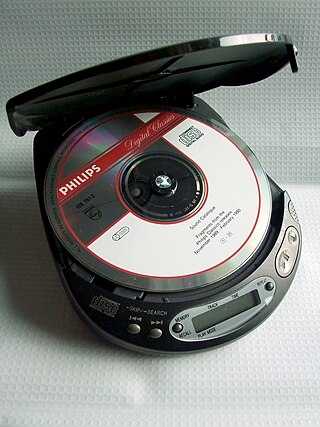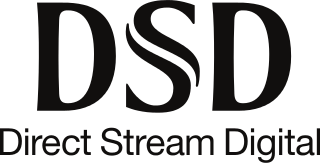
The compact disc (CD) is a digital optical disc data storage format that was co-developed by Philips and Sony to store and play digital audio recordings. In August 1982, the first compact disc was manufactured. It was then released in October 1982 in Japan and branded as Digital Audio Compact Disc. In terms of both audio formatting and the music industry, CDs reached their peak popularity in the 1990s, and has steadily declined since due to the rise of downloadable MP3 formats and streaming.

In telecommunication, a line code is a pattern of voltage, current, or photons used to represent digital data transmitted down a communication channel or written to a storage medium. This repertoire of signals is usually called a constrained code in data storage systems. Some signals are more prone to error than others as the physics of the communication channel or storage medium constrains the repertoire of signals that can be used reliably.

An optical disc is a flat, usually disc-shaped object that stores information in the form of physical variations on its surface that can be read with the aid of a beam of light. Optical discs can be reflective, where the light source and detector are on the same side of the disc, or transmissive, where light shines through the disc to be detected on the other side.

Compact Disc Digital Audio, also known as Digital Audio Compact Disc or simply as Audio CD, is the standard format for audio compact discs. The standard is defined in the Red Book, one of a series of Rainbow Books that contain the technical specifications for all CD formats.

MiniDisc (MD) is an erasable magneto-optical disc-based data storage format offering a capacity of 60, 74, and later, 80 minutes of digitized audio.

Digital Audio Tape is a signal recording and playback medium developed by Sony and introduced in 1987. In appearance it is similar to a Compact Cassette, using 3.81 mm / 0.15" magnetic tape enclosed in a protective shell, but is roughly half the size at 73 mm × 54 mm × 10.5 mm. The recording is digital rather than analog. DAT can record at sampling rates equal to, as well as higher and lower than a CD at 16 bits quantization. If a comparable digital source is copied without returning to the analogue domain, then the DAT will produce an exact clone, unlike other digital media such as Digital Compact Cassette or non-Hi-MD MiniDisc, both of which use a lossy data-reduction system.

Super Audio CD (SACD) is an optical disc format for audio storage introduced in 1999. It was developed jointly by Sony and Philips Electronics and intended to be the successor to the compact disc (CD) format.
Sound can be recorded and stored and played using either digital or analog techniques. Both techniques introduce errors and distortions in the sound, and these methods can be systematically compared. Musicians and listeners have argued over the superiority of digital versus analog sound recordings. Arguments for analog systems include the absence of fundamental error mechanisms which are present in digital audio systems, including aliasing and associated anti-aliasing filter implementation, jitter and quantization noise. Advocates of digital point to the high levels of performance possible with digital audio, including excellent linearity in the audible band and low levels of noise and distortion.

A CD player is an electronic device that plays audio compact discs, which are a digital optical disc data storage format. CD players were first sold to consumers in 1982. CDs typically contain recordings of audio material such as music or audiobooks. CD players may be part of home stereo systems, car audio systems, personal computers, or portable CD players such as CD boomboxes. Most CD players produce an output signal via a headphone jack or RCA jacks. To use a CD player in a home stereo system, the user connects an RCA cable from the RCA jacks to a hi-fi and loudspeakers for listening to music. To listen to music using a CD player with a headphone output jack, the user plugs headphones or earphones into the headphone jack.

The LaserDisc (LD) is a home video format and the first commercial optical disc storage medium, initially licensed, sold and marketed as MCA DiscoVision in the United States in 1978. Its diameter typically spans 30 cm (12 in). Unlike most optical-disc standards, LaserDisc is not fully digital, and instead requires the use of analog video signals.

Videodisc is a general term for a laser- or stylus-readable random-access disc that contains both audio and analog video signals recorded in an analog form. Typically, it is a reference to any such media that predates the mainstream popularity of the DVD format. The first mainstream official Videodisc was the Television Electronic Disc (TED) Videodisc, and the newest is the 4K Ultra HD Blu-Ray Disc. As of September 2023, the active video disc formats are Blu-ray Disc, DVD, and in other regions because of the price difference from DVD, Video CD (VCD) and SVCD.

Direct Stream Digital (DSD) is a trademark used by Sony and Philips for their system for digitally encoding audio signals for the Super Audio CD (SACD).

A camcorder is a self-contained portable electronic device with video and recording as its primary function. It is typically equipped with an articulating screen mounted on the left side, a belt to facilitate holding on the right side, hot-swappable battery facing towards the user, hot-swappable recording media, and an internally contained quiet optical zoom lens.

In digital recording, an audio or video signal is converted into a stream of discrete numbers representing the changes over time in air pressure for audio, or chroma and luminance values for video. This number stream is saved to a storage device. To play back a digital recording, the numbers are retrieved and converted back into their original analog audio or video forms so that they can be heard or seen.
High Definition Compatible Digital (HDCD) is a proprietary audio encode-decode process that claims to provide increased dynamic range over that of standard Compact Disc Digital Audio, while retaining backward compatibility with existing compact disc players.

DVD recordable and DVD rewritable are optical disc recording technologies. Both terms describe DVD optical discs that can be written to by a DVD recorder, whereas only 'rewritable' discs are able to erase and rewrite data. Data is written ('burned') to the disc by a laser, rather than the data being 'pressed' onto the disc during manufacture, like a DVD-ROM. Pressing is used in mass production, primarily for the distribution of home video.

Compact disc manufacturing is the process by which commercial compact discs (CDs) are replicated in mass quantities using a master version created from a source recording. This may be either in audio form (CD-DA) or data form (CD-ROM). This process is used in the mastering of read-only compact discs. DVDs and Blu-rays use similar methods.

A CD-ROM is a type of read-only memory consisting of a pre-pressed optical compact disc that contains data. Computers can read—but not write or erase—CD-ROMs. Some CDs, called enhanced CDs, hold both computer data and audio with the latter capable of being played on a CD player, while data is only usable on a computer.
Super Bit Mapping (SBM) is a noise shaping process, developed by Sony for CD mastering.
High-resolution audio is a term for audio files with greater than 44.1 kHz sample rate or higher than 16-bit audio bit depth. It commonly refers to 96 or 192 kHz sample rates. However, 44.1 kHz/24-bit, 48 kHz/24-bit and 88.2 kHz/24-bit recordings also exist that are labeled HD Audio.















